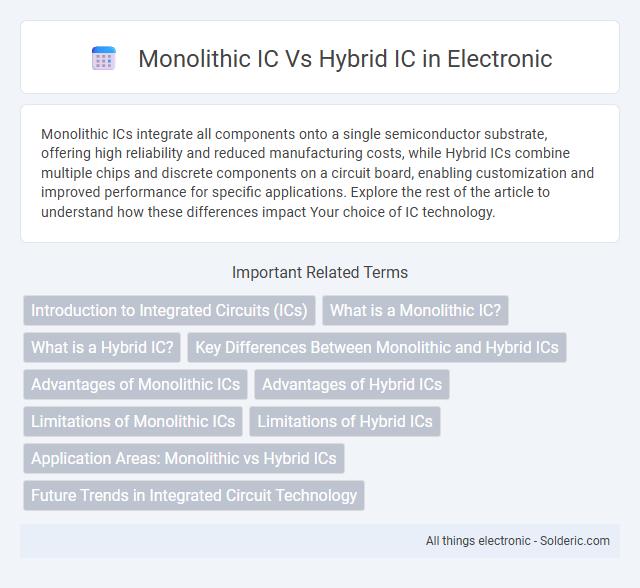Monolithic ICs integrate all components onto a single semiconductor substrate, offering high reliability and reduced manufacturing costs, while Hybrid ICs combine multiple chips and discrete components on a circuit board, enabling customization and improved performance for specific applications. Explore the rest of the article to understand how these differences impact Your choice of IC technology.
Comparison Table
| Feature | Monolithic IC | Hybrid IC |
|---|---|---|
| Definition | All components fabricated on a single semiconductor substrate. | Combines multiple components on different substrates into one package. |
| Fabrication | Complete fabrication on one chip using photolithography. | Assembly of separate components like resistors, capacitors, and chips on a ceramic or glass substrate. |
| Size | Smaller, compact design. | Relatively larger due to multiple discrete components. |
| Performance | Higher-speed operation, better reliability. | Good performance but slower compared to monolithic ICs. |
| Cost | Cost-effective for large-scale production. | More expensive due to complex assembly and materials. |
| Applications | Microprocessors, memory chips, digital ICs. | High-frequency RF circuits, sensor modules, and specialized analog circuits. |
| Heat Dissipation | Limited, requires efficient thermal management. | Better heat dissipation due to ceramic substrate. |
| Customization | Less customizable once fabricated. | Highly customizable, allows combining diverse components. |
Introduction to Integrated Circuits (ICs)
Monolithic ICs are fabricated on a single semiconductor substrate, enabling compact design and high reliability by integrating all components within one chip. Hybrid ICs combine multiple discrete components, such as resistors, capacitors, and semiconductors, assembled on a ceramic or organic substrate to achieve flexible functionality and higher power handling. Integrated Circuits revolutionized electronics by miniaturizing circuits, improving performance, and reducing manufacturing costs in devices like computers, smartphones, and medical equipment.
What is a Monolithic IC?
A Monolithic IC (Integrated Circuit) is a semiconductor device where all electronic components such as transistors, resistors, and capacitors are fabricated on a single silicon substrate, ensuring compact size and high reliability. Unlike Hybrid ICs, which combine multiple discrete components on a substrate, Monolithic ICs offer superior electrical performance and manufacturing efficiency due to their unified construction. Understanding Monolithic IC technology helps you leverage its benefits in applications requiring miniaturization and consistent signal integrity.
What is a Hybrid IC?
A Hybrid Integrated Circuit (Hybrid IC) combines multiple discrete components, such as resistors, capacitors, and semiconductor devices, mounted on a single substrate to achieve specific circuit functions. Unlike Monolithic ICs, where all components are fabricated within a single semiconductor chip, Hybrid ICs integrate different materials and components to enhance performance and customization for specialized applications. This approach enables flexibility in design, improved thermal management, and the ability to incorporate components that are difficult to fabricate monolithically.
Key Differences Between Monolithic and Hybrid ICs
Monolithic ICs integrate all components onto a single semiconductor substrate, resulting in smaller size, higher reliability, and lower manufacturing cost, while Hybrid ICs combine multiple discrete components on a ceramic or organic substrate, offering greater design flexibility and improved performance for high-frequency applications. Monolithic ICs are ideal for mass production with consistent specifications, whereas Hybrid ICs excel in customized or high-power environments due to their ability to incorporate various component types. Thermal management and assembly complexity are significantly higher in Hybrid ICs compared to the monolithic approach, impacting overall system design and maintenance.
Advantages of Monolithic ICs
Monolithic ICs offer superior performance due to their compact design, resulting in faster signal processing and higher reliability compared to Hybrid ICs. The integration of all components on a single silicon chip minimizes parasitic capacitance and inductance, enhancing electrical characteristics and reducing manufacturing costs. These ICs also exhibit better thermal stability and easier mass production, making them ideal for high-volume electronic applications.
Advantages of Hybrid ICs
Hybrid ICs offer superior flexibility by integrating multiple semiconductor materials and discrete components into a single module, enhancing performance in high-frequency and high-power applications. Their ability to withstand harsh environments, including extreme temperatures and mechanical stress, makes them ideal for aerospace and military uses. Furthermore, hybrid ICs enable customization for specific circuit requirements, improving reliability and reducing overall system size compared to monolithic ICs.
Limitations of Monolithic ICs
Monolithic ICs face limitations such as restricted component variety and limited power handling capabilities due to their single-substrate design. Thermal dissipation issues arise from the dense integration of elements, impacting performance and reliability. The manufacturing process constraints limit customization and the integration of discrete passive components compared to Hybrid ICs.
Limitations of Hybrid ICs
Hybrid ICs face limitations such as higher manufacturing costs and increased complexity compared to monolithic ICs, which impacts scalability and mass production. The differences in coefficient of thermal expansion between components can lead to reliability issues in harsh environments. Your design choices must consider these constraints to ensure optimal performance and durability.
Application Areas: Monolithic vs Hybrid ICs
Monolithic ICs are widely used in consumer electronics, medical devices, and communication systems due to their compact size, high reliability, and cost-effectiveness. Hybrid ICs, featuring a combination of different semiconductor materials and discrete components, excel in aerospace, military, and high-frequency radar applications where customization and performance under extreme conditions are critical. Your choice between monolithic and hybrid ICs should align with the specific requirements of the application area, balancing factors like integration level, environmental resilience, and signal integrity.
Future Trends in Integrated Circuit Technology
Monolithic ICs continue to advance with enhanced miniaturization and improved performance through cutting-edge semiconductor fabrication processes, while Hybrid ICs offer versatility by combining different materials and components on a single substrate, enabling specialized functions. Future trends emphasize the integration of advanced materials such as silicon carbide and gallium nitride in both IC types to boost power efficiency and thermal management. Your choice between Monolithic and Hybrid ICs will depend on the application's need for scalability, performance, and customization in next-generation electronics.
Monolithic IC vs Hybrid IC Infographic

 solderic.com
solderic.com